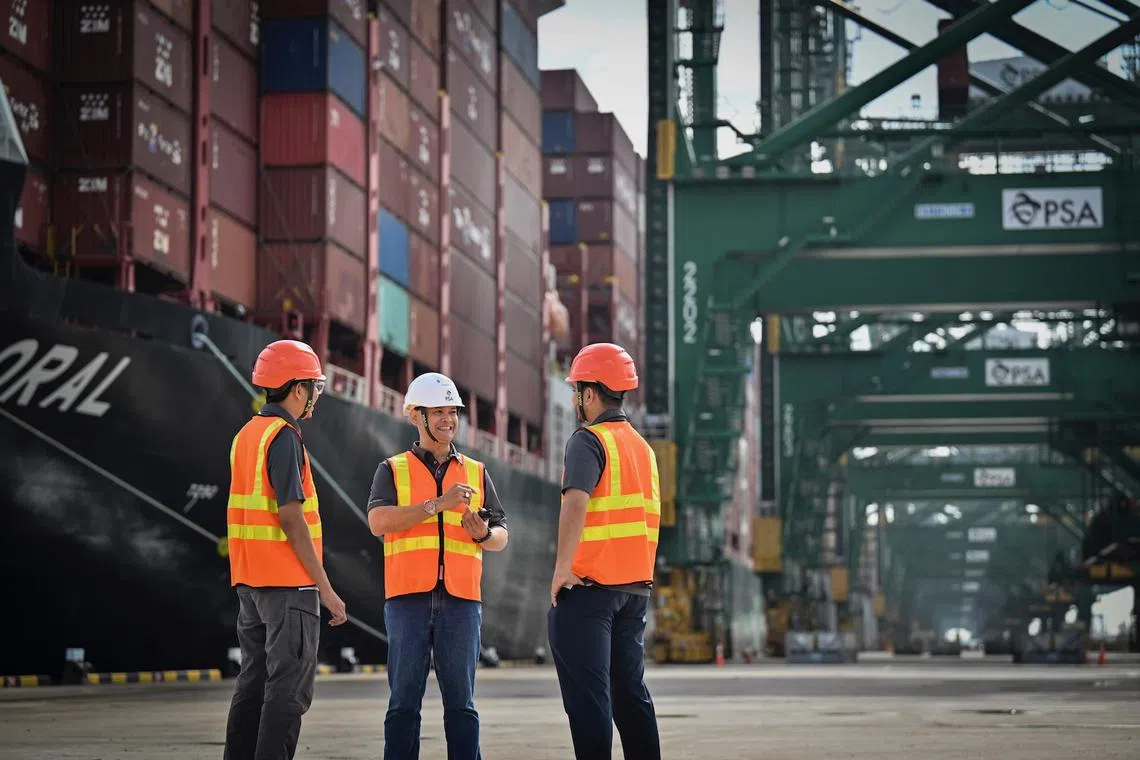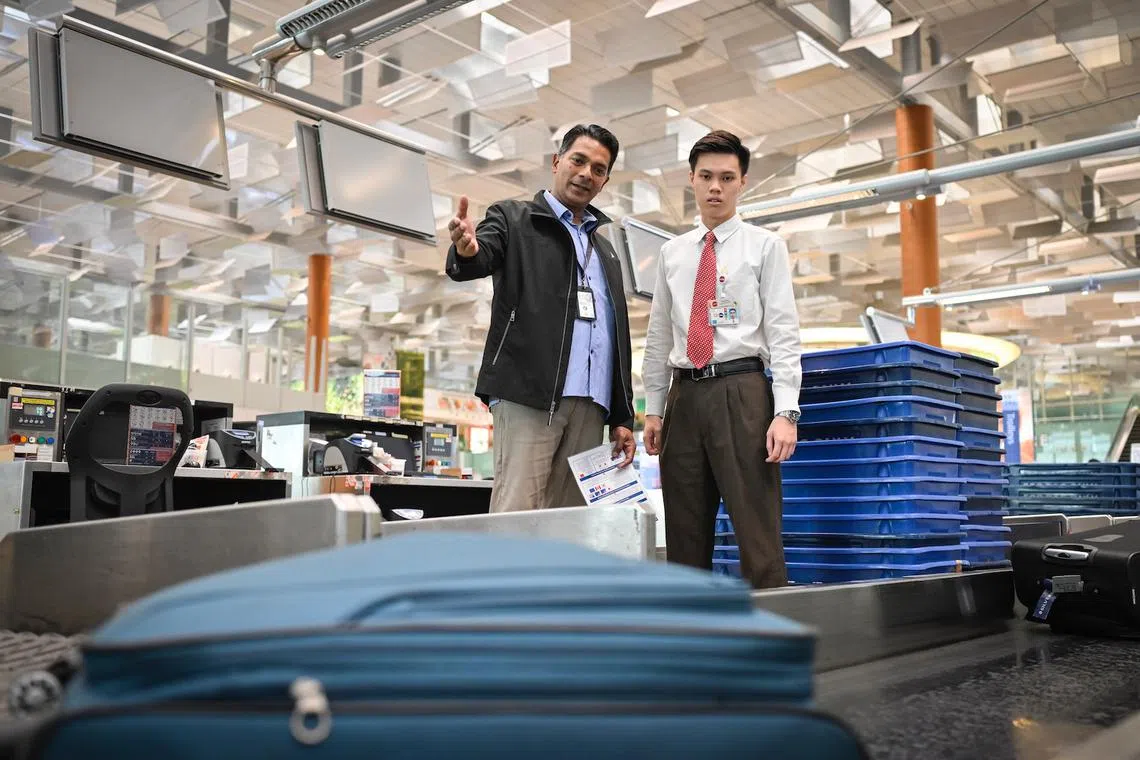What it takes to power one of the world’s busiest air and sea hubs
From automated cranes to generative AI-powered tools, these Temasek portfolio companies are boosting connectivity with smarter solutions
Kareyst Lin &
Kareyst Lin
For years, his workdays began the same way – with a climb.
Rain or shine, Mr Syed Mohamed Ali would scale a 38-metre quay crane partly by foot, before taking an elevator up to the operator’s cabin at Pasir Panjang Terminal.
He joined PSA Singapore in 1994 as a manual crane operator at Keppel Terminal.
From his cabin, Mr Ali would pore over stacks of paper, highlighter in hand, mapping out which containers needed moving.
Today, the view from his “cabin” looks different. Mr Ali, 54, now an assistant operations executive at Tuas Port, oversees training of the semi-automated double trolley quay crane specialists and resource planning – in an air-conditioned control centre.
Tuas Port was officially opened in 2022. It is expected to be completed in the 2040s, and is already the world’s largest fully automated port now.
Like Mr Ali, over 100 PSA employees with experience in port operations are upskilled each year, says Mr Ong Kim Pong, group chief executive officer of PSA International. They then transition to different roles with support from the unions.

Mr Ali’s three-decade journey with PSA – formerly known as Port of Singapore Authority – is more than a story of personal growth.
It reflects the company’s evolution, as PSA grew from operating Singapore ports into a global company facilitating international trade and connecting cargo from origin to destination.
PSA operates the world’s largest transshipment hub in Singapore, which is also the world’s second-busiest container port.
Stepping out
The shift began when the Port of Singapore Authority was corporatised in 1997, with Singapore investment firm Temasek becoming its sole shareholder.
Mr Ong describes it as “a pivotal move that propelled (PSA) beyond Singapore’s shores”. Through strategic acquisitions and partnerships over the years, PSA reduced its reliance on a single market, expanded its overseas network and established its presence across key trade routes.
The turning point came in the 2000s, when Temasek helped the company undertake a bold restructuring and deepen its sustainability push – two key areas that would define PSA’s future.
- Restructuring: In 2000, PSA was planning for a public listing. But Temasek felt that it needed to prioritise restructuring its portfolio, as PSA had a large and varied portfolio at that time. Over 18 months, Temasek helped carve out PSA’s real estate holdings into a company called Mapletree. This enabled PSA to focus on its port business and improve its performance.
- Sustainability: PSA aims to achieve net zero carbon emissions by 2050, and has been partnering Temasek on its sustainability journey. “As Tuas Port scales up, PSA is leading the charge in green port initiatives,” says Mr Ong, “including electrification of port equipment, adoption of cleaner fuels and energy-efficient buildings.”
“(Temasek helped us in areas like) streamlining non-core assets, sharpening our focus on port operations and fortifying our global competitiveness for long-term growth,” adds Mr Ong.
At the heart of this vision is Tuas Port, which has 11 berths currently in operation.
By the 2040s, all of PSA Singapore’s container terminals will be consolidated at Tuas Port, with a total of 66 berths and an annual handling capacity of 65 million TEUs.
This single hub, at the westernmost edge of Singapore, will be a critical node in the global maritime industry, says Mr Ong.
“As Tuas Port scales up, PSA is leading the charge in green port initiatives, including electrification of port equipment, adoption of cleaner fuels and energy-efficient buildings.”
Mr Ong Kim Pong, group CEO of PSA International
Tech takes flight
As Tuas Port consolidates the flow of goods in Singapore’s west, the island’s eastern side hums with a different kind of movement: People.
In 2024, 67.7 million passengers passed through Changi Airport – a stark contrast to 2020, when the Covid-19 pandemic brought global travel to a standstill.
For the operations team at Singapore Airlines (SIA), it was an unforgettable time.
Terminals were silent, check-in counters were empty, and conveyor belts stood still, recalls Mr Aldrin Arumugam, manager of SIA’s Global Baggage Operations.
Mr Arumugam, 56, oversees baggage services across SIA’s global network, which handles over 94,000 pieces of baggage daily.
“No passengers (during the pandemic) meant no bags. And for an operations team like ours, that raised a big question: What do we do?”

Thinking digital
The downtime provided an opportunity to rethink operations, says Mr Arumugam, who has been working at SIA for 28 years. His team was able to strip down processes, refine policies, and make operations more efficient, he adds.
One project that took shape during this period: A self-help tool for filing damaged baggage reports on the SIA website, powered by generative artificial intelligence (gen AI).
Customers would be advised on the next steps within just two hours. “If the bag is repairable, our vendor will contact the customer to pick it up,” Mr Arumugam says.
“If it’s beyond repair, we will arrange for a replacement or compensation; and in cases where it’s assessed to be normal wear and tear, the system (directly) issues an insurance letter for claims.”
What once took up to eight days is now resolved in just 48 hours, with accuracy of up to 98 per cent, says Mr Arumugam.
This portal is one of around 50 gen AI initiatives that SIA has launched over the past two years.
Those who have visited SIA’s website would be familiar with its gen AI-powered search function and flight recommender, which offers personalised travel suggestions based on users’ preferences and KrisFlyer miles.
SIA chief executive Goh Choon Phong says the airline has long-standing investments in digital capabilities. In 2019, SIA launched KrisLab, a digital innovation lab where employees can collaborate to develop tech-driven solutions that address business challenges.
“As early adopters of gen AI, (we have been using it) to enhance customer experience, improve efficiencies, drive revenue generation and boost productivity.”
He adds that SIA sees technology as key to generating impactful business outcomes and maintaining the airline’s competitive edge.
“Unlike most airline groups, SIA does not have a domestic market and operates entirely on international routes,” Mr Goh explains. “(We) are alert to changes in market dynamics and demand patterns – (employing) advanced data analytics to continuously monitor trends and swiftly optimise our routes.”
“As early adopters of gen AI, (we have been using it) to enhance customer experience, improve efficiencies, drive revenue generation and boost productivity.”
Mr Goh Choon Phong, CEO, Singapore Airlines
Transforming together
Temasek, SIA’s major shareholder, currently holds a 53.5 per cent stake in the national carrier. SIA was part of Temasek’s initial portfolio of 35 companies in 1974.
“At Temasek, our ownership mindset informs our engagement with portfolio companies,” says Ms Juliet Teo, joint head of Temasek’s Portfolio Development Group and head of Singapore Market.
“Over the years, we have partnered with PSA and SIA to (transform), enhance their resilience and create sustained value.”
That transformation is felt on the ground too. For Mr Arumugam, it means greater efficiency. For Mr Ali, who has spent his entire career at PSA, it’s also deeply personal.
1994 was the year he joined PSA, and the year he got engaged – building career and family in tandem.
In 2022, he stepped into a new role: Training younger crane operators. His four kids – now aged 22 to 29 – were proud.
They used to look up to him simply as their father, Mr Ali says, but now “I’m (also) their role model”.
The same can be said about PSA and SIA, both leaders in their own industries on the global stage. “Their success is integral to (Temasek’s) performance – and will ultimately benefit future generations of Singaporeans,” says Ms Teo.
“The growth of Temasek’s portfolio companies from local to regional and global leaders reflects Singapore’s pioneering spirit and its DNA of determination, innovation and vision.
“As an active shareholder, Temasek engages them to enhance shareholder value as they grow their competitive edge and generate sustainable long-term returns, while fostering meaningful change for people and communities – so every generation prospers.”
– Mr Dilhan Pillay Sandrasegara, executive director and chief executive officer, Temasek
Our Singapore DNA, a series in partnership with Temasek, spotlights how home-grown companies in its portfolio have grown into regional and global leaders. It also explores how Temasek has partnered them throughout their journeys.
This was first published in The Straits Times.
Decoding Asia newsletter: your guide to navigating Asia in a new global order. Sign up here to get Decoding Asia newsletter. Delivered to your inbox. Free.
Share with us your feedback on BT's products and services
